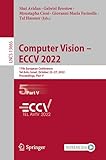Computer Vision - ECCV 2022 [electronic resource] : 17th European Conference, Tel Aviv, Israel, October 23-27, 2022, Proceedings, Part V / edited by Shai Avidan, Gabriel Brostow, Moustapha Cissé, Giovanni Maria Farinella, Tal Hassner.
Contributor(s): Avidan, Shai [editor.] | Brostow, Gabriel [editor.]
| Brostow, Gabriel [editor.] | Cissé, Moustapha [editor.]
| Cissé, Moustapha [editor.] | Farinella, Giovanni Maria [editor.]
| Farinella, Giovanni Maria [editor.] | Hassner, Tal [editor.]
| Hassner, Tal [editor.] | SpringerLink (Online service)
| SpringerLink (Online service) .
.
Material type:  BookSeries: Lecture Notes in Computer Science: 13665Publisher: Cham : Springer Nature Switzerland : Imprint: Springer, 2022Edition: 1st ed. 2022.Description: LV, 749 p. 249 illus., 241 illus. in color. online resource.Content type: text Media type: computer Carrier type: online resourceISBN: 9783031200656.Subject(s): Computer vision
BookSeries: Lecture Notes in Computer Science: 13665Publisher: Cham : Springer Nature Switzerland : Imprint: Springer, 2022Edition: 1st ed. 2022.Description: LV, 749 p. 249 illus., 241 illus. in color. online resource.Content type: text Media type: computer Carrier type: online resourceISBN: 9783031200656.Subject(s): Computer visionAdaptive Image Transformations for Transfer-Based Adversarial Attack -- Generative Multiplane Images: Making a 2D GAN 3D-Aware -- AdvDO: Realistic Adversarial Attacks for Trajectory Prediction -- Adversarial Contrastive Learning via Asymmetric InfoNCE -- One Size Does NOT Fit All: Data-Adaptive Adversarial Training -- UniCR: Universally Approximated Certified Robustness via Randomized Smoothing -- Hardly Perceptible Trojan Attack against Neural Networks with Bit Flips -- Robust Network Architecture Search via Feature Distortion Restraining -- SecretGen: Privacy Recovery on Pre-trained Models via Distribution Discrimination -- Triangle Attack: A Query-Efficient Decision-Based Adversarial Attack -- Data-Free Backdoor Removal Based on Channel Lipschitzness -- Black-Box Dissector: Towards Erasing-Based Hard-Label Model Stealing Attack -- Learning Energy-Based Models with Adversarial Training -- Adversarial Label Poisoning Attack on Graph Neural Networks via Label Propagation -- Revisiting Outer Optimization in Adversarial Training -- Zero-Shot Attribute Attacks on Fine-Grained Recognition Models -- Towards Effective and Robust Neural Trojan Defenses via Input Filtering -- Scaling Adversarial Training to Large Perturbation Bounds -- Exploiting the Local Parabolic Landscapes of Adversarial Losses to Accelerate Black-Box Adversarial Attack -- Generative Domain Adaptation for Face Anti-Spoofing -- MetaGait: Learning to Learn an Omni Sample Adaptive Representation for Gait Recognition -- GaitEdge: Beyond Plain End-to-End Gait Recognition for Better Practicality -- UIA-ViT: Unsupervised Inconsistency-Aware Method Based on Vision Transformer for Face Forgery Detection -- Effective Presentation Attack Detection Driven by Face Related Task -- PPT: Token-Pruned Pose Transformer for Monocular and Multi-View Human Pose Estimation -- AvatarPoser: Articulated Full-Body Pose Tracking from Sparse Motion Sensing -- P-STMO: Pre-trained Spatial Temporal Many-to-One Model for 3D Human Pose Estimation -- D&D: Learning Human Dynamics from Dynamic Camera -- Explicit Occlusion Reasoning for Multi-Person 3D Human Pose Estimation -- COUCH: Towards Controllable Human-Chair Interactions -- Identity-Aware Hand Mesh Estimation and Personalization from RGB Images -- C3P: Cross-Domain Pose Prior Propagation for Weakly Supervised 3D Human Pose Estimation -- Pose-NDF: Modeling Human Pose Manifolds with Neural Distance Fields -- CLIFF: Carrying Location Information in Full Frames into Human Pose and Shape Estimation -- DeciWatch: A Simple Baseline for 10Ö Efficient 2D and 3D Pose Estimation -- SmoothNet: A Plug-and-Play Network for Refining Human Poses in Videos -- PoseTrans: A Simple yet Effective Pose Transformation Augmentation for Human Pose Estimation -- Multi-Person 3D Pose and Shape Estimationvia Inverse Kinematics and Refinement -- Overlooked Poses Actually Make Sense: Distilling Privileged Knowledge for Human Motion Prediction -- Structural Triangulation: A Closed-Form Solution to Constrained 3D Human Pose Estimation -- Audio-Driven Stylized Gesture Generation with Flow-Based Model -- Self-Constrained Inference Optimization on Structural Groups for Human Pose Estimation.
The 39-volume set, comprising the LNCS books 13661 until 13699, constitutes the refereed proceedings of the 17th European Conference on Computer Vision, ECCV 2022, held in Tel Aviv, Israel, during October 23-27, 2022. The 1645 papers presented in these proceedings were carefully reviewed and selected from a total of 5804 submissions. The papers deal with topics such as computer vision; machine learning; deep neural networks; reinforcement learning; object recognition; image classification; image processing; object detection; semantic segmentation; human pose estimation; 3d reconstruction; stereo vision; computational photography; neural networks; image coding; image reconstruction; object recognition; motion estimation.


There are no comments for this item.